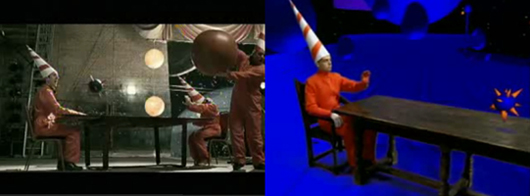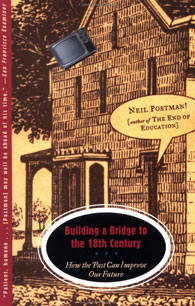In 2004, as the Matrix Ping Pong video link bounced its way from inbox to inbox, people where amused by the re-creation of a ping pong match with Matrix style special effects, using people instead of computer technology. Viewers were amazed at the elaborate costumes, only to be topped by even more amazing choregraphy. Perspective changes and camera angles are reproduced. Influences of Matrix 360 camera spinning and earlier Cantonese martial arts films are pervasive. Part of its success was the evident work and planning that was required to design and execute the scene. The idea of simulating the simulated was both ingenious and topical. However media criticism aside, it’s just a pleasure to watch.
The clip comes from a popular Japanese television show Kasou Taishou, where contestants performs skits before a panel of judges. These skits often involve re-creating camera work and special effects of film. That same year, Neil Tennant and Chris Lowe of the UK pop band Pet Shop Boys release the video for the song “Flamboyant.” In the video, a (stereo)typical Japanese corporate employee is seen struggling to design a skit for the show. Interspersed in the video are mock Japanese ads starring Tennant and Lowe. Two years later, they take the idea one step further recently their their new video, for “I’m with Stupid.” In it, Matt Lucas and David Walliamsthe stars of the British comic skit series “Little Britian” to replicate PBS videos “Go West” and “Can You Forgive Her.” The result is a bizarre re-intereption of the CGI intensive PBS videos.
When I first started on this post, I was going to try to say that these examples are a “reaction” to the increasing virtual parts of lives. However, my thinking has shifted towards this reading this phenomenon as the process of “reflection” that has a long traditional in cultural production. As our lives are becoming increasingly virtual, synthetic, and digital, our analogue lives reflect back the new digital nature of what we experience. Like a house of mirrors, people are reflecting back what they see. These mirrors, as found in the amusement parks, distort the original image, bending and stretching people’s reflection, but not beyond recognition. The participants on Kasou Taishou started copying the images from the Matrix, which itself is a reflection or new interpretation of the fight choreography of Cantonese martial arts films. Pet Shop Boys first merely replay their reflection (with splices of fake Japanese commerical staring themselves.) Things get much more interesting when Tennant and Lowe realize that the truly interesting part of the Flamboyant video was re-creating the digital with the analogue, while adding their own personal distortion through a distinctly British comedic lens.

Advances in telecommunication and media production technology have blown open the opportunity to create and share these types of cultural call and response we are witnessing. The history of parody is a prime example of this, a traditional cultural dialogue through media artifacts. I’m not all surprised, in this case, that Japan is playing a role here. In that, I have always been both fascinated and amazed by the observed way that Japanese culture seems to balance the respect of tradition with the advancement of modernity, especially with technology. Although, I realize that distance and language barriers may mask the tensions between these cultural forces. Part of the balance is achieved by taking the old and infusing it into the new rather than completely reject the old. Further, in the case of the real simulating the virtual, the diversity of modes of creation and distribution is extremely telling. Traditional roles are blurred. The one-to-many versus many-to-many broadcast models, East v. West cultural dominance, corporate v. independent media and pro/am production distinctions are being rendered meaningless. The end result is a far richer landscape of cultural production.
Category Archives: matrix
podcast: discussing neil postman’s “building a bridge to the 18th century”
 (Annotated audio recordings of this discussion appear further down.)
(Annotated audio recordings of this discussion appear further down.)
On the dedication page of “Building a Bridge to the 18th Century,” Neil Postman quotes the poet Randall Jarrell:
Soon we shall know everything the 18th century didn’t know, and nothing it did, and it will be hard to live with us.
Though often failing to provide satisfying answers, Postman asks the kind of first-order questions one hears all too infrequently at a time when technology’s impact on our social, political and intellectual lives grows ever more profound. Postman has been accused of deep reactionism toward technology, and indeed, his hostility toward computers and telecommunications betrays an elitism that discredits some of his larger, and quite compelling observations.
In spite of this, Postman’s diagnosis is persuasive: that the idea of technological progress bequeathed by the Enlightenment has detached from reason and become a runaway train, that we are unquestioningly embracing new technologies that unleash massive change on our family and communal life, our democracy, and our capacity to think critically. We have stopped asking the single most important question that should be applied to all new technological innovations: does this technology solve a problem? If so, then at what cost? To whose benefit? And at whose expense?
Postman portrays the contemporary West as a culture without a narrative, littered with the shards of broken ideologies – depressed, unmotivated, and therefore uncritical of the new technologies that are foisted upon it by a rapacious capitalist system. The culprit, as he sees it, is postmodernism, which he lambasts (rather simplistically) as a corrosive intellectual trend, picking at the corpse of the Enlightenment, and instilling torpor and malaise at all levels of culture through its distrust of language and dogged refusal to accept one truth over another. This kind of thinking, Postman argues, is seductive, but it starves humans of their inspiration and sense of purpose.
To be saved, he goes on, and to build a better future, we would do well to look back to the philosophes of 18th century Europe, who, in the face of surging industrialization, defined a new idea of universal rational humanism – one that allowed for various interpretations within its fold, was rigorously suspicious of religious or any other kind of dogma, and yet gave the world a sense of moral uplift and progress. Postman does not suggest that we copy the 18th century, but rather give it careful study in order to draw inspiration for a new positive narrative, and for a reinvigoration of our critical outlook. This, Postman insists, offers us the best chance of surviving our future.
Postman’s note of alarm, if at times shrill, is nonetheless a refreshing antidote to the techno-optimism that pervades contemporary culture. And his recognition of our “crisis in narrative” – a formulation borrowed from Vaclav Havel – is dead on.
September 19: Bob, Dan, Kim, and Ben discuss Postman’s book at our new Brooklyn office (special prize if you pick out the sound of the ice cream truck passing by).
1. Bob’s preface – thoughts about how we do business at the institute (1:56) (download)
2. Ben’s first impressions – childhood under threat… Dan’s first impressions into discussion – a Clinton-era book, sets up a rather straw man caricature with the postmodernists, but society’s need for a narrative is compelling – why the Christian right has done so well… Postman seems to be assuming that progress is a law, that there is a directed narrative to history – problems with how he treats evolution. (6:43) (download)
3. Bob: Postman is much better at identifying problems than at coming up with solutions. Which is what makes him compelling. His stance is courageous. People assume with technology that just because something can be done it should be done. This is a tremendous problem – an affliction. If you could go back in time and be the inventor of the automobile, would you do it? People get angry at the responsibility this question imputes to them. How can we put these big questions at the center of our work? (13:34) (download)
4. Another big question… “An electronic community is only a simulation of a real community”? Flickr, Friendster, Howard Dean campaign? What is the vehicle for talking about this? What format is best for engaging these questions? Looking for new forms that illuminate or activate the questions. (15:43) (download)
5. Where/who are the public intellectuals today? [The ice cream truck passes by.] Strange bifurcation of the intellectual elite – many of the best-educated people most able to deal with abstraction make their living producing popular media that controls society. (10:07) (download)
6. Is capitalism the problem? Postman’s bias: written language will never be surpassed in its power to deal with abstract thought and cultivation of ideas. But we are arguably past the primacy of print. What is our attitude toward this? (9:39) (download)
7. What opportunities for reflection do different media afford? Films on DVD can be read and reread like a book – the viewer controls, rather than being controlled – a possibility for reflection not available in broadcast. What is the proper venue for discussing this? Capitalism is the 800 lb. gorilla in the room. How do we create, if not a mass agitation, then at least a mass discussion? Tie it to the larger pressing problems of the world and how they will be better addressed by certain forms of discourse and reflection. Averting ecological catastrophe as one possible narrative – an inspiring motivator that will get people moving. How do find our way back into history? (10:09) (download)
8. What should we read next as counterpoint/antidote to Postman? The Matrix – are we headed that way? (12:33) (download)
9. How do we organize new kinds of debates about technology and society? Other issues to be addressed – class, race and gender inequality. (11:26) (download)
